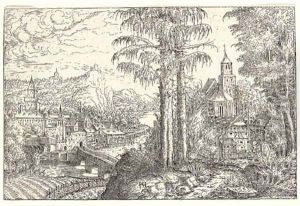Hanns Lautensack Paintings
Hanns Lautensack was a German artist, primarily known for his work as an engraver and printmaker during the Northern Renaissance period. Born in 1524 in Bamberg, Germany, Lautensack was part of a family of artists; his father, Thomas Lautensack, was also a painter. However, there is not much information available about Hanns's early life or training. What is known suggests that he likely learned the craft of engraving within his family.
Lautensack moved to Vienna in 1554, where he became part of the artistic circle at the Habsburg court. His work during this period was influenced by other Northern artists, including Albrecht Dürer and Daniel Hopfer, and he developed a style that was known for its intricate detail and complex compositions. Lautensack's engravings often depicted religious subjects, as well as portraits and landscapes. He was particularly adept at capturing the human face and his portraits are highly regarded for their expressiveness and character.
One of Lautensack's most famous works is the engraving 'The Penitent Magdalene', which showcases his skill in rendering textures and his sensitive approach to the subject. His landscape prints were also notable for their pioneering use of the etching technique, which was relatively new at the time.
Despite his talents, Hanns Lautensack did not achieve widespread fame during his lifetime. Records indicate that he faced financial difficulties and he moved frequently in search of patronage. He spent his latter years in Frankfurt and it's believed he died there in 1566.
Lautensack's body of work was modest in size, but his technical skill and the quality of his prints contributed significantly to the art of engraving in the 16th century. Today, his engravings are considered valuable examples of Renaissance art and are studied for their historical and artistic importance. They can be found in various art museums and collections around the world.
